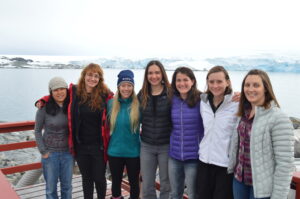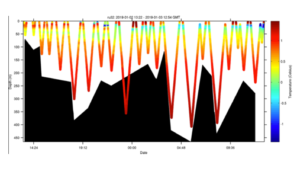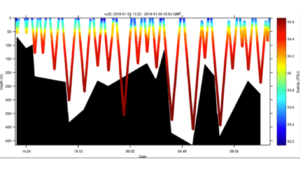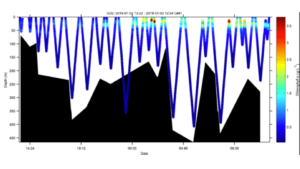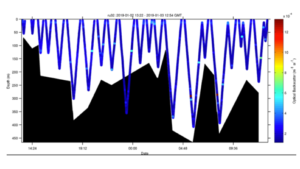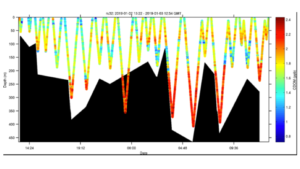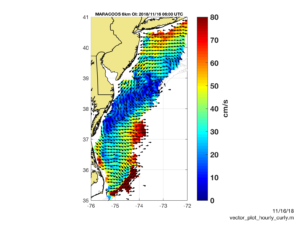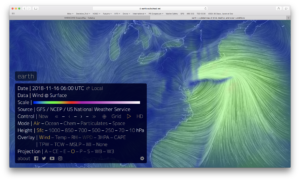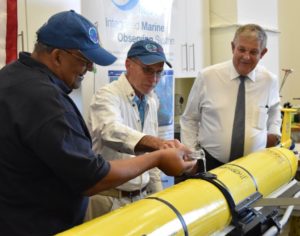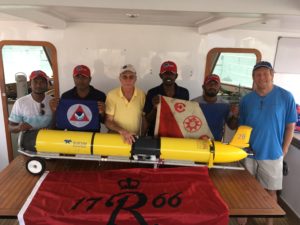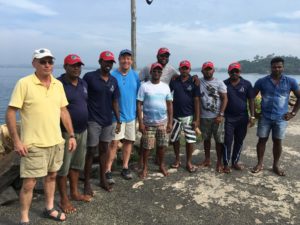-
The science team for 2019
Posted on January 7th, 2019 No commentsRutgers Sends All Female Field Team to Antarctica for the 27th year of the Palmer LTER
The 27th Annual research cruise of the Palmer Long Term Ecological Research (LTER) (www.pal.lternet.edu) along the Western Antarctic Peninsula set sail on January 5, 2019 and will continue until February 7, 2019. The LTER annual cruise will be surveying the Western Antarctic Peninsula, studying the entire food web – from phytoplankton and bacteria to krill and other zooplankton to whales and penguins – working to understand the changing ecosystem and the influences climate change is having along the peninsula. The Palmer Station component of the LTER project, also in its 27th year, also adds a seasonal scale to the study, running from October 2018 to April 2019.
This season, the phytoplankton component of the Palmer LTER, headed by Dr. Oscar Schofield, has an all female field team! Led by Field Team Lead, Nicole Waite (RUCOOL Technician), team members include: Dr. Kim Thamatrakoln (DMCS Assistant Research Professor), Emily Slesinger (RUCOOL graduate student), Samantha Schofield (Rutgers undergraduate student), and Hailey Conrad (Rutgers undergraduate student). The Palmer Station field team is lead by Schuyler Nardelli (RUCOOL graduate student) who is also doing her dissertation research with the Palmer LTER and Marie Zahn (field technician). Not pictured, Anna Bashkirova (Rutgers undergraduate) was also a key member of the field team at Palmer Station from October to December 2018.
Picture Caption: From L-R: Kim Thamatrakoln, Samantha Schofield, Emily Slesinger, Marie Zahn, Schuyler Nardelli, Hailey Conrad, Nicole Waite. Not pictured: Anna Bashkirova
-
Glider is launched offshore Palmer Station
Posted on January 3rd, 2019 No commentsWeather cooperated and the LTER team was able to launch a glider this Wednesday offshore Palmer Station. Hopefully the ice will cooperate and we maintain a sustained presence for the rest of the summer season. The glider this year is outfitted with a SeaBird CTD, WetLabs fluorometer and optical backscatter sensor. The glider is also carrying a ASL Environmental Sciences multifrequency acoustic system to measure zooplankton and fish. The goal of this years mission is to measure the variability of phytoplankton, zooplankton, and fish distributions and their relationship to penguins and whales. Currently the glider is transecting back and forth along the head of the Palmer Deep canyon. Below is the glider location along the WAP (A) and the a zoom-in showing its movements near palmer station over the last 24 hours (B).
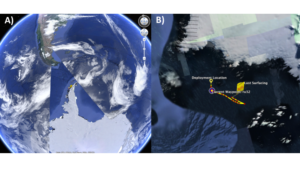
The figure below is the cross section of the water temperature. The black shapes is the “estimated sea floor” as measured by the onboard glider altimeter. The altimeter is obviously giving some false bottoms, as the glider is transecting deeper the altimeter derived sea floor. This has been seen before, and our working hypothesis is the altimeter is getting returns on large krill swarms not the seafloor. The AZFP will provide insight on this. Temperatures show a typical range for this location, with warm water at the surface (presumably reflecting radiant heating) and at depth reflecting remnant modified circumpolar deep water. A cooler layer at 30-50 meter water depth probably reflects residual cold surface water.
The salinity shows a fresher surface layer with a salinity at 33 to 33.2. This likely reflects sea ice and glacial melt.
Chlorophyll fluorescence shows a surface bloom at the eastern portion of the transect indicating a moderately sized phytoplankton bloom.
Optical backscatter shows no strong correlation with the surface phytoplankton. However there does appear to be particles at depth which could be consistent with export flux events with the material potentially ranging from marine snow to animal poop.
Finally Colored Dissolved Organic Matter (CDOM) shows significant variability, however the deep modified circumpolar deep waters are distinct with a high fraction of fluorescent CDOM.
-
Introducing the Polar Oceans Blog
Posted on December 23rd, 2018 No comments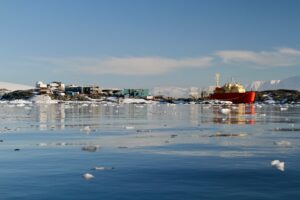
Palmer Station and ASRV Laurence M. Gould docked at the pier. Photo by Marie Zahn, summer 2018.Welcome to the RUCOOL Polar Oceans blog! Here we will share updates from our research conducted along the West Antarctic Peninsula (WAP) from Palmer Station and while aboard the R/V Laurence M. Gould. Our research contributes to the Palmer Long-Term Ecological Research (LTER) program (https://pal.lternet.edu) that monitors decadal ecological changes of the pelagic marine ecosystem along the WAP. The Palmer LTER program was established by the National Science Foundation in 1990 and combines efforts from several universities to examine the whole food web from bacteria to seabirds and cetaceans.
Our research objectives are to understand seasonal and interannual patterns and changes in the phytoplankton as well as the physical properties (temperature, salinity, and light) that affect them, especially as this region warms and shifts from a true Antarctic ecosystem to a more sub-Antarctic one. More specifically, we focus on how the physics and nutrient availability drive overall carbon fixation in the upper ocean and how that relates to higher trophic levels. Our routine analyses include discrete chlorophyll a measurements, 14C uptake to determine primary productivity, chemotaxonomic pigments via high performance liquid chromatography, fluorescence induction and relaxation kinetics, and whole water carbon fixation rates. We compliment these measurements with water column bio-optical profiles.
This austral summer marks our eleventh season at Palmer Station. Already it has been a productive one (pun-intended). Stay tuned for more updates and posts as we go deeper into some of our protocols and recent findings from our research here in Antarctica!
-
Aging HF Radar Network
Posted on December 17th, 2018 No commentsThe MARACOOS HF Radar Network was formed in 2007 with the funding of the proposal “Phased Deployment and Operation of the Mid Atlantic Regional Coastal Ocean Observing System (MARCOOS)”. The network has grown from 24 stations in 2007 up to 38 stations in 2018. The network has been delivering hourly surface currents to the US Coast Guard since May 2009 with no interruption. However the age of the network is weighing on the operations as some of the stations in the network are approaching 20 years of service. The figure below chronicles the age of the radars in the network as of 2018.
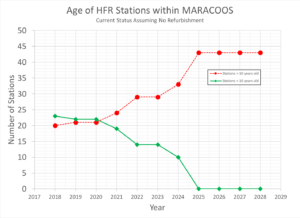 Time line indicating the age of the HF Radar stations in the Mid Atlantic. The green line indicates stations that are less than 10 years old while red shows number of stations with a service life greater than 10 years.
Time line indicating the age of the HF Radar stations in the Mid Atlantic. The green line indicates stations that are less than 10 years old while red shows number of stations with a service life greater than 10 years. -
RUCOOL Operations Update for October-November 2018
Posted on December 6th, 2018 No commentsRU COOL Updates: October & November 2018
Field Campaign & Science Updates
State
- The REI Offshore Wind Working Group, in collaboration with Rutgers State Relations, is accelerating partnership development with the Governor’s office, NJBPU, NJDEP, and offshore wind developers, and commercial fishing. Highlights include discussions with developers on performing right whale detections with gliders, meetings with NYSERDA to develop plans for federal DOE investments, meetings with commercial fishing groups to promote state interests in both fishing and offshore wind energy. RUCOOL has been recognized as international leader in environmental science and engagement for offshore wind.
- Supporting NJ DEP state monitoring of coastal water quality glider mission completed for Fall
- RU COOL develops a new satellite product increasing the amount and overall quality of satellite sea surface temperature critical to fishermen, weather forecasters, energy companies and offshore wind. The new coldest pixel product is now provided in real time on the Oceansmap.maracoos.org development server (public launch projected in December)
- World’s first ocean acidification (pH) glider completed its second ever deployment
- Testified for the NJ Assembly of Environment and Solid Waste Committee regarding offshore wind
- RU COOL’s new website released
- RUCOOL has lobbied to establish the nation’s first State Oceanographer starting when Joe Seneca was VP for Academic Affairs. We have never been closer to achieving this historic goal for New Jersey.
National
- Two long deployment (>2 months) MARACOOS gliders recovered after patrolling the Mid-Atlantic in support of joint efforts with NOAA and Navy to collect data to improve hurricane forecasting
- RU COOL briefs the leadership of US Coast Guard, US Navy, and Acting Director of NOAA
- MARACOOS welcomes in new Board of Directors, critical step for RU to lead next proposal in 2-years
- New web based glider data quality product delivered via ERDAPP, critical to Gulf of Mexico RFP due in late winter
International
- RU COOL arrives at Palmer Station Antarctica and begins sampling for the 27th field season for the LTER program.
- At the MarCuba conference in Havana, developed the process to establish an MOU between InsMet (Cuban Weather Service), Rutgers and Texas A&M to bring the first HF Radars to Cuba, significantly expanding the international HF Radar Network in the Gulf of Mexico for the National Academy of Science Loop Current Program.
- Challenger glider recovered offshore Sri Lanka and returned to Rutgers after a hypothesized giant squid attack, shifting efforts to Magellan Glider Mission to 500 years later race Magellan around the world.
- Trained researchers at PLOCAN Glider School, Canary Islands
- Led the Global Ocean Observing System HF-Radar Webinar
- Established the new MTS Unmanned Untethered Vehicle (UUV) committee, including leading the kick off Town Hall that included NOAA, Navy and Industry leadership.
New Awards
- National Science Foundation, Ocean Sciences 2018-2020 “Engaging Faculty and Students in Learning with OOI Data Explorations” ($981,608) McDonnell
- National Science Foundation, 2018-2019, “Educational support and synthesis based on the initial phase of the Ocean Observatories”, ($435,888) Glenn
- National Academy of Sciences (Univ. Of Southern Mississippi) 2018-2020, “Gulf of Mexico Loop Current and Eddy Observations from HF Radar Systems”, ($338,349), Glenn (first of 3)
- NOAA, 2018-2019: “Coupled Atmosphere-Ocean Modeling Framework: WRF and ROMS” ($351,218), Miles
Papers: (**Current or Former Graduate Student or Postdoctoral Researchers)
- Goldsmith, K.A., Lau, S., Poach, M.E., Sakowicz, G.P., Trice, T.M., Ono, R.C., Nye, J., Shadwick, E.H., Saba, G.K. In review. Scientific Considerations for Acidification Monitoring in the U.S. Mid-Atlantic Region. Estuarine, Coastal and Shelf Science.
- Greer, A., Schofield, O., Miles, T., et al. (2018), Functioning of Coastal River-Dominated Ecosystems and Implications for Oil Spill Response: From Observations to Mechanisms and Models, Oceanography, 31(3), doi:10.5670/oceanog.2018.302.
- Kohut, J., Glenn, S., McDonnell, J., Miles, T., Saba, G., Schofield, O. Workforce Development Supporting the Blue Economy: A Master’s Program of Integrated Ocean Observing at Rutgers University. OCEANS’18 MTS/IEEE, Charleston, SC, USA, 2018, pp. 1-8.
- Miles, T., Slade, W., **Gong, D., and Kohut, J. Suspended particle characteristics from a Glider integrated LISST sensor. MTS/IEEE Oceans. Charleston, SC. In Press.
- **Oliver, M., Kohut, J., Bernard, K., Fraser, W., Winsor, P., **Statscewich, H., Fredj, E., Cimino, M., Patterson-Fraser, D., **Carvalho, F. 2018. Central place foragers select ocean surface convergent features despite differing foraging strategies. Scientific Reports. In Press.
- Prakash, Dicopoulos, Roarty, Morel, Canals, **Evans (2018) “Development of Sargassum Seaweed Tracking Tools” MTS Oceans – in press
- Saba, G.K., Goldsmith, K.A., Cooley, S.R., Grosse, D., Meseck, S.L., Miller, W., Phelan, B., Poach, M., Rheault, R., St. Laurent, K., Testa, J., Weis, J.S., Zimmerman, R. In review. Recommended Priorities for Research on Ecological Impacts of Coastal and Ocean Acidification in the U.S. Mid-Atlantic. Estuarine, Coastal and Shelf Science.
- Chave, R., Buermans, J., Lemon, D., Taylor, J.C., Lembke, C., DeCollibus, C., Saba, G.K., Reiss, C.S. 2018. Adapting Multi-Frequency Echo-sounders for Operation on Autonomous Vehicles. OCEANS’18 MTS/IEEE, Charleston, SC, USA, 2018, pp. 1-6.
- Kohut, J., Glenn, S., McDonnell, J., Miles, T., Saba, G., Schofield, O. Workforce Development Supporting the Blue Economy: A Master’s Program of Integrated Ocean Observing at Rutgers University. OCEANS’18 MTS/IEEE, Charleston, SC, USA, 2018, pp. 1-8.
- Saba, G.K., **Wright-Fairbanks, E., Chen, B., Cai, W.-J., Barnard, A.H., Jones, C.P., Branham, C.W., Wang, K., Miles, T. 2018. Developing a profiling glider pH sensor for high resolution coastal ocean acidification monitoring. OCEANS’18 MTS/IEEE, Charleston, SC, USA, 2018, pp. 1-8.
- **Yi, X., Glenn, S., **Carvalho, F., Jones, C., Kohut, J., McDonnell, J., Miles, T., **Seroka, G., Schofield O. 2018. Glider technology enabling a diversity of mesoscale ocean sampling capabilities. In Challenges and Innovations in Ocean In-Situ Sensors, Delory and Pearlman (Eds). Elsevier, York. Pp. 367-374.
- Schofield, O., Aragon, D., Jones, C., Kohut, J., Miles, T. N., Roarty, H., Saba, G., **Yi, X., Glenn, S. 2018. Maturing glider technology providing a modular platform capable of mapping ecosystems in the ocean. In Challenges and Innovations in Ocean In-Situ Sensors, Delory and Pearlman (Eds). Elsevier, York. 173-193.
RU COOL Significant Meetings & Conferences
LTER Tri-Annual Network Wide Meeting, Radar Operators Working Group, Bermuda Biological Station Glider training, American Wind Energy Association Offshore Windpower, US Army Corps of Engineers, Marine Technology Society Meetings, MARACOOS Board Meeting, State of the Science Workshop – Biodiversity Research, NJ Spotlight Offshore Wind Energy, NOAA Headquarters-Hurricanes, US NAVY CNMOC – Hurricanes, Multiple Orsted meetings, OCEANS 2018 Charleston (5 RUCOOL speakers), Rutgers Ideation meeting, KIOST – Rutgers Joint Program Agreement Meeting.
RU COOL Visitors
- Total number of visitors to RU COOL: >150 (November only)
- Visitors: RU Undergrad Class, Orsted, North Jersey High Schools STEM students, UK Embassy with Industry, RU Potential Undergrad Tours, NJ-BPU, KIOST (Korea), ICBM Oldenburg Germany, RU Foundation & Wentworth family
RU COOL Recognitions
- Travis Miles: 2018 Marine Technology Society Young Professional Award
- Oscar Schofield: 2019 winner of Evelyn G. Hutchinson Award by the American Society of Limnology & Oceanography
-
Ocean Response to Winter Storm
Posted on November 16th, 2018 No commentsA storm moved through the Mid Atlantic on November 15, 2018. The MARACOOS High Frequency radar network captured the center of the low pressure system as it moved north past Delaware and New Jersey.
The surface winds from the Global Forecast System (GFS) had the center of the low further inshore.
We’ll continue to analyze these two data sets to understand the discrepancy.
-
RU29 – 2 years ago
Posted on November 8th, 2018 No commentsChari just sent this photo from the Perth glider port looking back 2 years at the re-christening of RU29 with water from the Indian Ocean before the start of its historic mission within IIOE-2.
Looking back at all that was accomplished, I first think of all the people that made it possible. Working together, we advanced the technology, we explored an ocean with new threats, and we overcame new challenges on shore. We made new friends, and together, accomplished something that was hard. Some call these types of friends comrades, some call them mates. In Spanish, we call them companeros. Our co-workers, our partners, our equals. All dedicated to a common goal. Companeros have a bond that has been tested, and a bond that has survived, because of a shared vision that is bigger than our differences.
With the return of RU29, we now focus our attention on the next mission. I look forward to working with all of you as we prepare to redeploy from Spain in September of 2019. The preparations will be hard, and seeing the mission through to the end will be even harder.
But we are companeros.
Borrowing words from our global navigator – Force, wind and honor all.
-
Recovery Team Photos
Posted on November 2nd, 2018 No commentsRU29 recovery team arrives at the fishing port of Marissa. Flags are from NOAA, the Explorers Club and Rutgers. Captain and crew of the Marissa wearing red RUCOOL caps.
Entire group back onshore by the Marissa Fishing Marina.
-
RU29 Damage – First look
Posted on November 2nd, 2018 No commentsFirst approach. Usual barnacles. Rudder is still attached but is hard over.
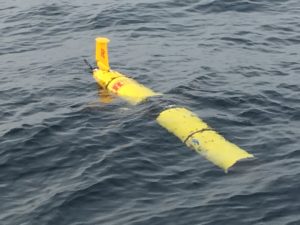
On board the Crystal. Deep scratches on the tail, port side.
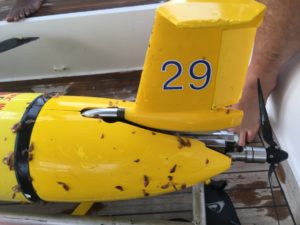
Deeper scratches on the starboard side.
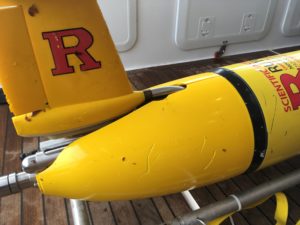
Forward energy bay has numerous scratches.
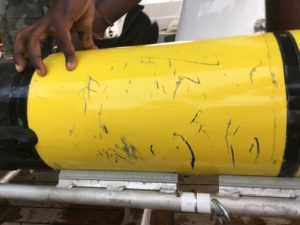
Pitch battery hull scratched on the bottom.
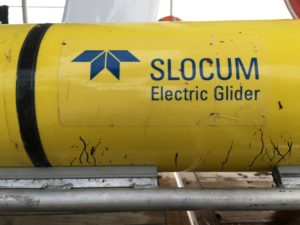
-
Hello from Marissa
Posted on November 1st, 2018 No commentsOscar and I are here in Marissa, same place we picked up RU29 after its record breaking mission flying from Perth, Australia.

RU29 is currently 8 nautical miles due south of Marissa Harbor. It is still in deep water to help with station keeping. The surface currents are strong, so we like to wait at depth.
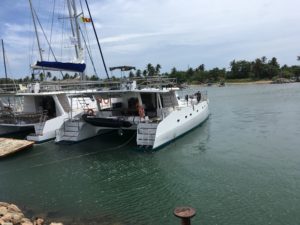
Our boat is the catamaran Crystal. We stopped by today to see the vessel and meet the captain and crew. We have two staircases down to the water level platform, one on each side. The captain and lookouts will be on the upper deck as we approach the glider.
Tomorrow’s schedule in Sri Lanka times:
Van pick up at hotel 4:30 am. At boat by 5 am. Boat loaded and set up for 5:30 am – 6:00 am departure. On site by about 7 am our time. We’ll get the current location of RU29, and a waypoint to head to that is just to the east of the current location. We head to our waypoint and then turn west, approaching the glider with the sun at our back. We will be standing on the upper deck looking for the glider with the Iridium phone getting text updates of location and the gps to let us know which way to go.



